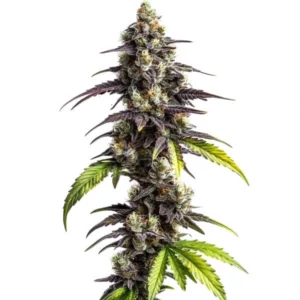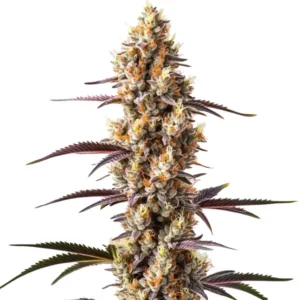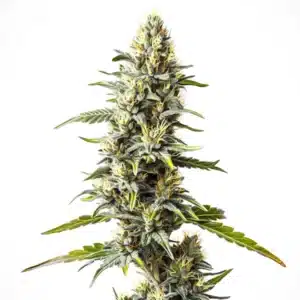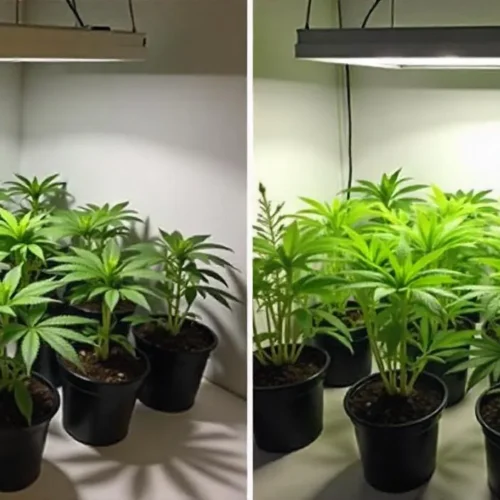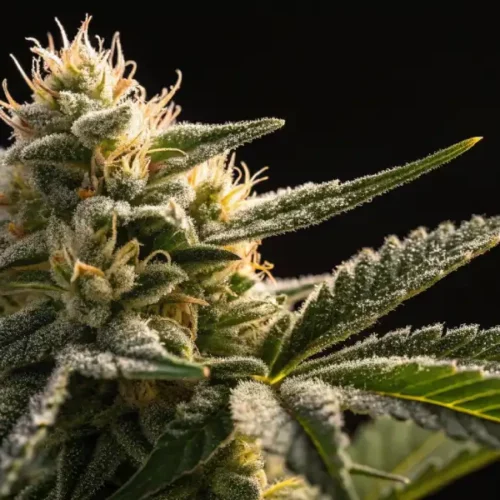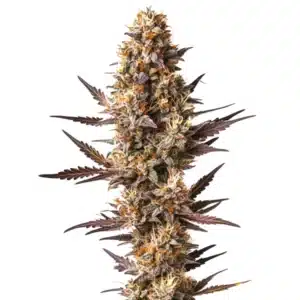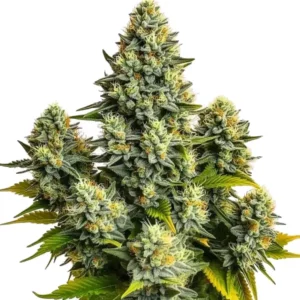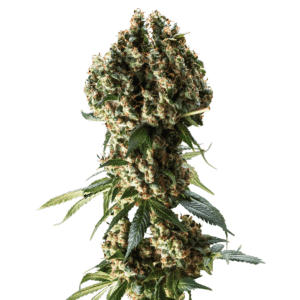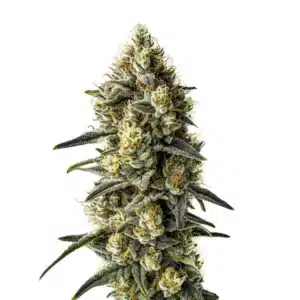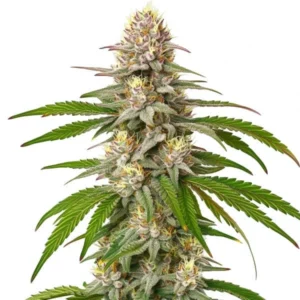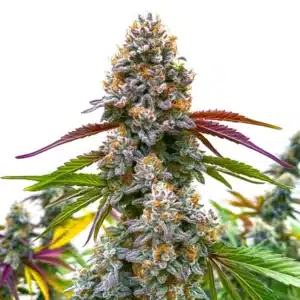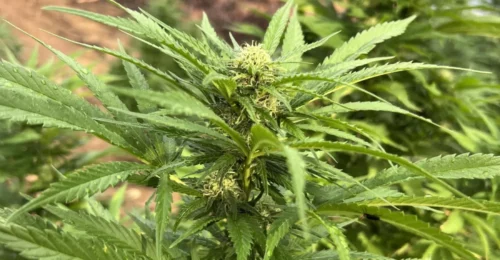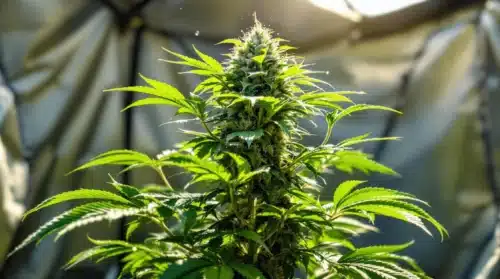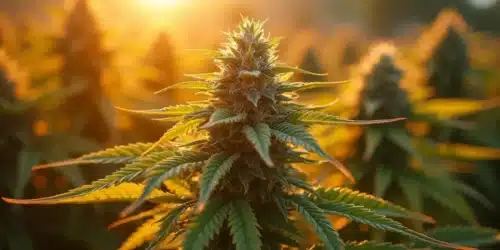Purple Pineapple Weed Strain Description
Purple Pineapple Strain is a highly regarded cannabis strain among growers and enthusiasts, known for its rich fruity aroma and balanced effects. This strain is primarily indica-dominant (70% Indica / 30% Sativa), making it an ideal choice for those seeking a relaxing and euphoric experience. The buds of the Purple Pineapple Weed Strain are distinguished by their dark green and purple hues, accented by bright orange hairs and a generous coating of trichomes.
With THC levels ranging from 20% to 24%, Purple Pineapple Weed offers a potent experience for both recreational and medicinal users. Its genetic lineage comes from a cross between Purple Kush and Pineapple, resulting in a plant that is robust and capable of producing high-quality buds. The terpene profile features myrcene, caryophyllene, and limonene, which contribute to its delightful pineapple, citrus, and floral flavors.
Recommended Strains
Purple Pineapple
 THC: 20% - 24%
THC: 20% - 24% Type of seed: Feminized
Type of seed: Feminized Phenotype: Mostly Indica
Phenotype: Mostly Indica Day to flower: 8 - 9 weeks
Day to flower: 8 - 9 weeks
Alaskan Purple
 THC: 15 - 20%
THC: 15 - 20% Type of seed: Feminized
Type of seed: Feminized Phenotype: Mostly Indica
Phenotype: Mostly Indica Day to flower: 8 - 10 weeks
Day to flower: 8 - 10 weeks
The combination of flavors and aromas in Purple Pineapple Weed Strain is what truly sets it apart. The sweet pineapple aroma mixed with earthy and floral undertones creates an invigorating experience for the senses. This strain’s effects are often described as relaxing, euphoric, and uplifting, making it suitable for evening use or to unwind after a long day.
Promos & Deals
Environmental Requirements for Growing Purple Pineapple Weed Strain
Creating the perfect environment for Purple Pineapple Weed Strain is essential for successful growth and optimal yield. This indica-dominant hybrid thrives in a warm, sunny climate, with ideal temperatures ranging from 70-85°F (21-29°C) during the day. Consistent temperature and humidity levels are crucial to avoid plant stress and to prevent mold or mildew formation.
When growing Purple Pineapple indoors, use high-quality LED grow lights or HPS lamps to provide the necessary light intensity for healthy plant growth. During the vegetative phase, an 18-20 hour light cycle is ideal, while during the flowering phase, switching to a 12/12 light cycle is necessary. Proper ventilation is also crucial to maintain fresh airflow, preventing mold and keeping the plants healthy.
For outdoor cultivation, Purple Pineapple Strain requires plenty of direct sunlight to achieve its full potential. It grows well in nutrient-rich, well-draining soil. Protecting the plant from extreme weather conditions, such as strong winds or heavy rainfall, will ensure its overall health. In cooler climates, a greenhouse setup can extend the growing season and provide additional protection for the plants.
Setting Up The Growing Cannabis Space
Properly setting up your growing space is essential for cultivating Purple Pineapple Weed Strain successfully. Whether growing indoors or outdoors, consider these factors to create an optimal growing environment:
Indoor Cannabis Cultivation
For indoor cultivation, selecting a spacious grow tent or a dedicated grow room is essential. Purple Pineapple is indica-dominant but can still grow quite tall, so ensure your space allows for vertical growth. Adequate ventilation, including an exhaust system with a carbon filter, helps maintain airflow and reduces odor. Reflective materials, such as Mylar, can be used on the walls to improve light efficiency within the space.
The growing medium can be high-quality soil or a hydroponic system, depending on your preference and experience. Purple Pineapple responds well to both methods, but it is essential to ensure good drainage and maintain a pH level of 6.0-6.5 for optimal nutrient absorption. Training techniques, such as low-stress training (LST), can help manage plant height and improve light exposure to lower branches.
Outdoor Cannabis Cultivation
When growing Purple Pineapple Weed Strain outdoors, select a location with maximum sun exposure. The soil should be well-draining, rich in organic matter, and maintained at a pH level between 6.0 and 6.5. If the local soil is not ideal, use large fabric pots or containers filled with a quality soil mix for better control over the growing conditions.
Providing support for the branches is also important, as Purple Pineapple can produce dense buds that may cause branches to bend or break. Stakes or trellises can help keep the plant upright and promote healthy growth. Additionally, ensure the plants are spaced apart to allow good airflow, reducing the risk of mold or mildew in humid conditions.
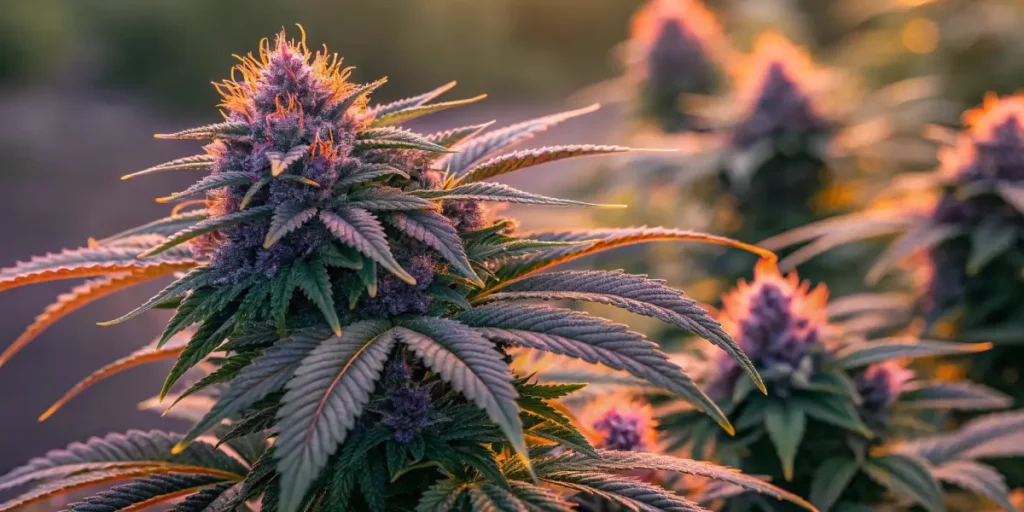
Propagation and Germination of Purple Pineapple
Successful germination of Purple Pineapple Weed Strain seeds is the foundation of a healthy and productive grow. Follow these steps to ensure a high germination rate:
1. Select high-quality Purple Pineapple feminized seeds from a trusted source to ensure the best genetic traits.
2. Begin the germination process by placing the seeds in a glass of distilled water or between damp paper towels for 24-48 hours. Maintain a temperature between 70-85°F (21-29°C) and keep the environment dark and undisturbed.
3. Once the seeds show taproots, plant them gently in a pre-moistened growing medium, such as seedling trays or small pots with light soil. Keep the soil moist but not waterlogged.
4. Maintain a temperature of around 75-80°F (24-27°C) with a humidity level of 60-70% to help the seedlings establish roots. Gentle airflow is also recommended to prevent fungal issues.
5. Provide indirect light for the seedlings during the first few days, gradually increasing light intensity as they grow. Once they develop a few sets of true leaves, they are ready for transplanting to larger pots or their final outdoor location.
Vegetative Phase of Purple Pineapple Weed Seeds
During the vegetative stage, Purple Pineapple Weed Strain requires specific care to promote healthy growth and strong structural development:
Lighting: Provide 18-20 hours of light per day to encourage vegetative growth. High-quality LED grow lights or HPS lamps ensure the plant receives sufficient intensity to support rapid growth.
Nutrition: During this phase, the plant needs a higher nitrogen (N) content in its nutrient solution to promote vigorous leaf and stem growth. Monitor for any signs of nutrient deficiencies and adjust the feed accordingly.
Watering: Water when the top inch of the soil is dry, and avoid overwatering, which can lead to root rot. Allowing the soil to dry out slightly between waterings will help the roots grow stronger.
Training: Low-stress training (LST) and topping techniques are highly recommended for Purple Pineapple during the vegetative phase to manage its height and encourage multiple bud sites for higher yields. Keeping an even canopy ensures better light distribution.
Pruning: Remove lower leaves and branches that receive minimal light to improve airflow and direct energy towards the plant’s upper growth. Proper pruning will also help reduce the chances of mold or pest infestations.
Flowering Phase of Purple Pineapple Weed Strain
The flowering stage is when Purple Pineapple Weed Seeds showcases its beautiful buds and aromatic qualities. Here are the key factors for successful flowering:
Lighting: Switch the light cycle to 12 hours of light and 12 hours of complete darkness to initiate flowering. Make sure the dark period is uninterrupted to avoid stressing the plants.
Nutrition: Use a bloom-specific nutrient formula with higher phosphorus (P) and potassium (K) to support bud development. Monitoring the plant for nutrient deficiencies is crucial during this stage to ensure healthy bud growth.
Temperature and Humidity: Maintain a temperature range of 65-75°F (18-24°C) with a humidity level of around 40-50% during flowering. This helps prevent mold while enhancing resin production.
Support: As the buds grow, they become dense and heavy. Providing support with stakes or trellises can prevent branches from snapping under the weight of the buds.
Flowering Time: Purple Pineapple typically has a flowering period of around 8-9 weeks. Harvest is generally ready in late September to early October, depending on the specific phenotype and environmental conditions. To determine the ideal harvest time, use a magnifier to check trichome color—they should be mostly milky with some amber hues for optimal potency.
Cannabis Fertilization and Nutrition
Proper nutrition is critical for Purple Pineapple Weed Strain to reach its full potential. Here are some tips for fertilization and nutrition throughout its life cycle:
Choosing the Right Fertilizer: Use a cannabis-specific fertilizer that provides a balanced mix of macro and micronutrients, including nitrogen, phosphorus, and potassium. Adding calcium and magnesium supplements can also help prevent common deficiencies.
Feeding Schedule: Follow a consistent feeding schedule and adjust nutrient concentrations based on the plant’s response. Purple Pineapple benefits from a slightly higher nitrogen level during the vegetative stage, transitioning to a phosphorus-rich formula during flowering.
Supplements: To improve plant health, consider using supplements like beneficial microbes, enzymes, and bloom boosters. These can enhance nutrient uptake and increase the yield and quality of the buds.
During the last two weeks of the flowering stage, flush the plants with pure water to remove any residual nutrients. This helps improve the flavor of the harvested buds by preventing harshness that might come from nutrient buildup.
Pest and Disease Control for Cannabis Growing
While Purple Pineapple Weed Strain is generally resilient, it is still vulnerable to pests and diseases. Here are some prevention and control tips:
Prevention:
- Inspect plants regularly for signs of pests such as aphids, spider mites, and thrips. Early detection can help prevent full-blown infestations.
- Maintain a clean grow space, remove dead plant material, and ensure adequate airflow to reduce the risk of mold or mildew.
- Introduce beneficial insects like ladybugs or predatory mites to control pests naturally without harsh chemicals.
- Use sticky traps to monitor pest activity and take action if necessary.
Corrective Actions:
- If pests are present, apply organic pest control products like neem oil or insecticidal soap. These are effective and safe for use on cannabis plants.
- For fungal issues like powdery mildew, remove affected plant parts and treat with an organic fungicide. Good airflow and reducing humidity levels are key to avoiding fungal infections.
- For severe infestations or persistent problems, consult with an experienced grower for specific recommendations on managing the situation effectively.
Harvesting and Curing for Cannabis Growing
Proper harvesting and curing of Purple Pineapple Weed Strain will ensure the best possible flavor and potency. Here’s what you need to do:
Trichome Maturity: Use a magnifying tool to check the trichomes. They should be mostly cloudy with some turning amber when the THC levels are at their peak, indicating the ideal time for harvest.
Harvesting: Use sterilized pruning shears to carefully cut branches, avoiding damage to the buds. Remove large fan leaves and hang the branches upside down to dry.
Drying: Hang the branches in a dark room with temperatures between 60-70°F (15-21°C) and a humidity level of around 50-60%. Proper drying typically takes 7-14 days, depending on conditions. Ensure adequate airflow to prevent mold.
Curing: Once dried, place the buds in airtight jars and store them in a cool, dark place. Open the jars daily for the first week to release excess moisture. This curing process can take 2-4 weeks, significantly enhancing the flavor and smoothness of the buds.
Is Purple Pineapple Weed Strain Indica or Sativa?
Purple Pineapple Weed Strain is primarily indica-dominant (70% Indica / 30% Sativa). It provides a relaxing and euphoric experience that makes it suitable for evening use. Despite its indica dominance, Purple Pineapple also offers uplifting and happy effects, making it versatile for both recreational and medicinal purposes. This balance makes Purple Pineapple an excellent choice for users looking for relaxation without feeling overly sedated.
Advantages of Growing Purple Pineapple Weed Seeds
- Rich pineapple and fruity flavor profile with floral and earthy undertones.
- High THC content suitable for experienced users.
- Produces dense buds with beautiful purple hues.
- Relaxing and euphoric effects, ideal for both recreational and medicinal use.
- Resistant to common pests and diseases.
- Adaptable to both indoor and outdoor cultivation.
Disadvantages of Growing Purple Pineapple Weed
- Can grow tall, requiring vertical space management indoors.
- Potential for strong odor during flowering, requiring proper odor control.
- Requires careful attention to nutrient levels to avoid deficiencies or excesses.
- May need training techniques to maximize yield and control height.
Why Buy Purple Pineapple Weed Strain
There are several compelling reasons to buy Purple Pineapple Weed Strain:
1. Unique Flavor: Purple Pineapple delivers a sweet, tropical pineapple flavor with floral and earthy undertones, making it a popular choice for cannabis connoisseurs.
2. Relaxing Effects: The indica-dominant effects provide a sense of relaxation and euphoria, perfect for unwinding in the evening or managing stress.
3. Medical Benefits: Purple Pineapple is often used to manage anxiety, depression, and fatigue due to its calming and mood-enhancing properties.
4. High Yield Potential: When grown under optimal conditions, Purple Pineapple can produce significant yields, making it an attractive option for cultivators looking for a rewarding harvest.
5. Adaptability: Purple Pineapple is adaptable to various growing methods, including indoor, outdoor, and greenhouse cultivation, making it suitable for different types of growers.
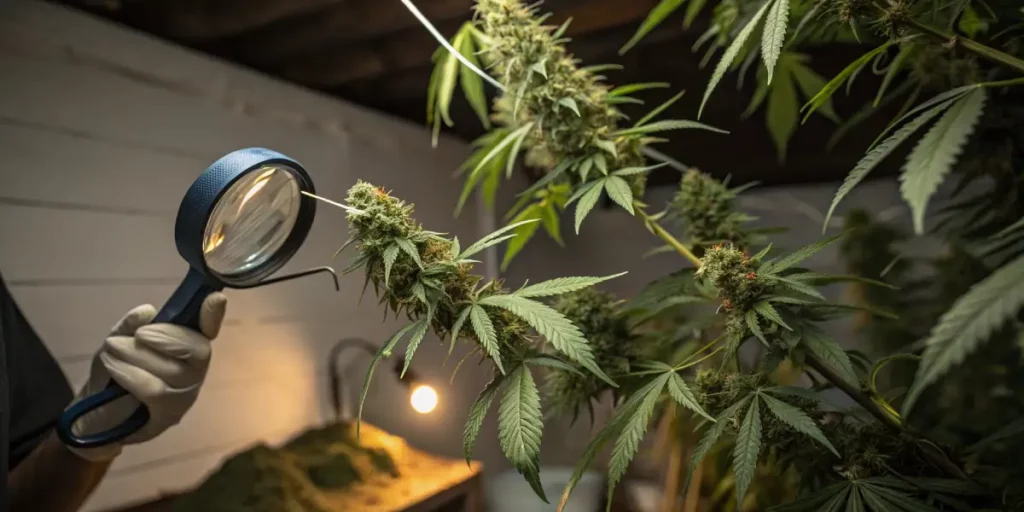
Problems in Cultivating Purple Pineapple Weed Strain
While Purple Pineapple Weed Strain is a rewarding strain to grow, some challenges may arise during cultivation:
1. Height Management: Purple Pineapple can grow quite tall, which may be challenging for indoor growers with limited vertical space. Training techniques such as topping and LST can help manage height.
2. Pest Control: Although Purple Pineapple is fairly resistant to pests, regular inspection is necessary to catch any issues early. Using natural pest deterrents can help keep the grow free of unwanted insects.
3. Odor Control: The strong aroma during the flowering stage can be challenging to manage. Installing carbon filters in indoor grows can help mitigate this issue and maintain discretion.
4. Nutrient Balance: Maintaining the correct nutrient levels is crucial. Purple Pineapple requires a well-balanced nutrient regimen, and any excess or deficiency can impact the health and yield of the plant.
Similar Strains to Purple Pineapple Weed Strain
- Pineapple Express: Known for its tropical flavors and uplifting effects, Pineapple Express shares similar genetic traits and provides a similar experience.
- Granddaddy Purple: This indica-dominant strain is also known for its relaxing effects and fruity aroma, making it an excellent alternative for those who enjoy Purple Pineapple.
Tips for Professional Growers
- Utilize SCROG Method: Screen of Green (SCROG) is highly effective for Purple Pineapple, as it helps manage height and increases yields by maximizing light exposure.
- Monitor Light Intensity: Purple Pineapple benefits from intense light during both vegetative and flowering stages. Ensure your lighting setup is adequate.
- Early Training: Start training the plant early in the vegetative stage to manage its height effectively and promote even growth across all bud sites.
- Climate Control: Maintain a stable temperature and humidity level during all stages of growth. Investing in good climate control equipment can significantly improve yield quality.
- Regular Monitoring: Consistently monitor pH levels and nutrient concentrations, and use supplements like silica to strengthen plant cell walls and support heavy buds.
FAQs
What is the THC content of Purple Pineapple Weed Strain?
Purple Pineapple Weed Strain has a THC content ranging from 20% to 24%, providing a potent and relaxing experience.
How long does it take for Purple Pineapple Weed Strain to flower?
The flowering time for Purple Pineapple Weed Strain is typically between 8-9 weeks, with harvest occurring from late September to early October.
Is Purple Pineapple suitable for beginners?
Purple Pineapple can be grown by beginners, but its tall growth structure requires some management techniques, making it easier for those with some prior experience.
What are the effects of Purple Pineapple Weed Strain?
Purple Pineapple offers relaxing, euphoric, and uplifting effects, making it ideal for evening use or managing stress and anxiety.
Can I grow Purple Pineapple indoors?
Yes, Purple Pineapple can be grown indoors, but it requires a spacious grow area due to its height. Proper training techniques can help manage height effectively.




